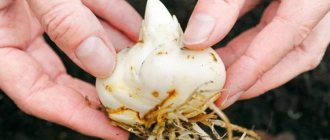When to dig up gladioli: Pexels The perennial gladiolus plant is not a winter-hardy flower. Therefore, its bulbs are dug up before frost begins. If you decide to grow this species in a flowerbed, stock up on knowledge on caring for the bulbs. Experienced gardeners share their secrets of when to dig up gladioli and how to store them properly.
Why do you need to dig up gladioli for the winter?
Gladioli are heat-loving plants that can winter safely only at above-zero temperatures outside if they are first covered with covering material for the winter. Russia has a rather harsh climate, so the flower, which reproduces by bulbs, must be dug up for the winter.
When the outside temperature reaches +9°C, most plants go to sleep to begin a new growing cycle in the spring.
In addition to low temperatures, gladiolus is also threatened by other dangerous factors:
- infectious diseases;
- fungi;
- rot;
- pests;
- rodents.
Therefore, even in warm climates, there is a high risk that the plant will not overwinter in open ground. Knowing how to properly dig up and store gladioli in the fall, you can propagate expensive varietal material and successfully preserve it for later planting.
Do I need to dig up gladioli for the winter?
Galina Aleksandrovna Kizima
Well-known gardener-practitioner, candidate of technical sciences. He runs the “6 acres” column in the Kaleidoscope newspaper, gives lectures at the Gardener’s House and on Radio Maria, and is the author of many articles and books on gardening.
Gladiolus has a two-tiered root system. Tuber buds form on the mother bulb in its upper part. If a large bulb dies in winter from freezing or excess moisture in the soil, the tuber will go deep into the soil along with the root system and die due to lack of nutrients.
What to do if it’s a long time before planting, but the gladioli begin to sprout?
Mostly corms of gladioli from early and early-mid flowering periods begin to germinate prematurely. Their rest period is shorter than that of the middle and late ones. There is nothing wrong with early germination for gladioli. High-quality planting material without signs of disease will be preserved normally until planting.
Premature germination of corms can also begin when humidity and temperature increase. Make sure that the storage temperature of gladioli does not exceed +5...+7°; dry the damp corms. Wrap in new dry newspaper (craft bag) and place on the bottom shelf of the refrigerator - healthy corms with sprouts will be well preserved until planting.
Find out more about growing gladioli from this article >>>>
Optimal timing for harvesting gladioli for the winter
All bulbous plants are dug out of the soil for the winter immediately after flowering. Before this you need to let them ripen. If this is not done, the bulb will not have time to accumulate nutrients that will help it survive the winter and then bloom profusely next summer. An unripe bulb may shoot without flower stalks or may not sprout at all after planting.
The surface part of the gladiolus will help you choose the right time. As soon as it completely turns yellow and dies, you can start working.
If you need to speed up the aging process of varieties that bloom in September, cut off the upper stems with flowers, leaving three at the bottom. The cut is made with a sharp knife at an angle of 45° and treated with potassium permanganate so that the gladiolus does not become infected with fungal and infectious diseases.
The timing should be based on the type and variety. Early flowering varieties are dug up earlier. After them, late varieties are dug up in the fall.
Experts also recommend following the digging order, taking into account the colors of their buds. First, you need to remove varieties whose flowers have the following colors:
- black;
- burgundy red;
- purple;
- purple;
- blue.
These species suffer more than others from mold, mildew and infectious diseases. To propagate rare varieties, it is imperative to leave shoots with flowers to allow the seed to ripen well.
Flowers grown from children are dug up last so that they have time to grow to normal size.
Autumn care
In autumn, gladioli need special care, which consists of moderate watering and feeding the bulbs. Late varieties should be watered in warm, clear weather once a week. The enrichment of early varieties with moisture ceases by autumn.
Remember, that:
- water for irrigation must be settled and heated;
- It is necessary to water up to 1/4 meter deep into the soil;
- per 1 m², from 1.5 to 2 buckets of water are used.
Loosening, weeding and hilling are necessary actions after watering. At the end of September, you can stop watering the gladioli - wait until digging.
Important! If you unnecessarily delay the length of time the cut bulbs remain in the ground, there will be a danger of them becoming infected with fungal spores.
It is important to feed the skewer during the growth and flowering season; by autumn, a one-time application of fertilizer is carried out. For this, potassium permanganate is used at the rate of 5 g per 1 bucket of water per 1 m² of planting.
There is a great sense in such feeding; it is carried out for two reasons:
- for saturation of nutrients;
- for disinfection.
How to properly dig up gladioli bulbs
Flower growers should know how to properly dig up gladioli in the fall and then store them all winter. First, remove the tying material. Then they dig up the bulbs. Garden tools should be inserted vertically into the ground at a distance of 7-10 cm from the stem so as not to damage the roots.
The earthen ball is lifted on a shovel, after which the gladiolus is pulled out of the ground by hand by the stem and placed on a prepared area. All the children gather from the hole so that the soil does not become clogged in the spring.
The stems are cut off or broken off immediately. The soil is removed from the bulbs. If necessary, they can be washed and then dried in an open place. The main onion is separated by cutting off its roots completely. Only intact specimens should be stored without damage. Plants can only be dug up in dry weather.
Preparation and processing of corms
Having studied the rules of digging and specified the time, you will need to carefully study the methods of processing the bulbs. When to dig up gladioli after flowering in the open ground at a dacha in the fall in the Middle Zone or in another Russian region, how to process them and how to properly store them in winter - all this is important for preserving gladioli until next spring.
How to protect tubers from diseases and pests
Thrips and other harmful microorganisms cause serious damage to gladiolus tubers. Thrips penetrate under the husk and drink all the juice from the flower bulb. After this, the gladiolus corm dies. Regular garlic and the special disinfectant Zineb help save gladiolus planting material from pests and diseases.
Garlic is placed in boxes where the corms will lie until spring, along with planting material. Use chopped slices. During each check of the condition of the flower bulbs, the dried pieces of garlic are replaced with fresh ones. When pests are already present, the bulbs are treated with Zineb. They are immersed in its solution for half an hour, then dried well for 2-3 days. The room where planting material dries must be well ventilated. After drying, the corms are again stored.
Methods for storing gladioli bulbs
In order to get beautiful gladioli next year, you need not only to know when to dig up the bulbs in the fall and how to store them in the winter, but what place to store them.
First, the planting material needs to be kept for a month in a warm room, where the temperature is kept at 20-25°C, regularly checking it for integrity. Specimens with rot and deformation are rejected, after which only the whole material is sent for winter storage, having selected the optimal option for wintering gladioli.
You can store it in different places where the following conditions are met:
- air temperature from +3 to +8°С;
- humidity no more than 65-70%;
- lack of light.
Different places may meet these conditions, so the gardener will always choose the most suitable option for winter storage of gladioli.
In the apartment or on the balcony
City residents can store bulbs in their apartment between balcony doors or window openings, placing them in cardboard boxes. The ideal option would be an insulated loggia with a cabinet on which you can control the air temperature.
If there is a strong drop in temperature, bring the bulbs into the room or additionally cover the boxes, protecting them from freezing. You can store planting material in a foam or cardboard box with small holes for ventilation.
In the cellar or basement
Owners of a country house can store seeding material in the basement or cellar along with vegetables. The box should be placed in a remote corner so that it does not absorb moisture. For storage, wooden boxes with sand are used, which are installed on racks.
In the trench
In the south, gladioli can be stored in prepared trenches 80 cm deep and 70 cm wide. The bulbs are laid out in wooden boxes, covered with sawdust and installed in the trenches.
A layer of straw or dry leaves is placed on top, and then covering material. Laying in trenches should be carried out in warm weather, when frost has not yet set in.
In a refrigerator
If there are few flowers on the site, you can store them in a regular refrigerator, in the vegetable compartment, wrapping each bulb in several layers of paper. At the end of winter, the bulbs need to be taken out, dried in a dark, warm place and wrapped again in paper, placing them on a shelf with a lower temperature.
In bags
Most often, bags made of natural fabric are used as packaging. As a rule, garlic or mothballs are placed in them to protect against pests.
This packaging allows air to pass through well and protects from light. If there is a shortage of space, they are hung in a dark, cool room.
In a warm attic
If you have a country house with an insulated attic, you can store gladioli in boxes there, placing them closer to the pipe. Each bulb must be wrapped in paper so that the moisture does not erode from them, sorting them according to variety.
In the pantry
In such a place you can hang the bulbs in bags or in old nylon tights under the ceiling. It is important that the room temperature is kept at +7...+10°C.
In the ash or in the river sand
To maintain an optimal microclimate, the bulbs can be stored in wood ash or river sand, which is pre-calcined in the oven. It is important that they remain dry throughout the winter.
The bulbs prepared for winter storage are covered with ash or sand so that they are completely covered.
Features of storing planting material in winter and what conditions are needed
Initially, in the fall, even in permanent containers, gladioli continue to dry. The optimal temperature for them is considered to be +23-26С. But the most important thing to ensure is that they are well ventilated. Every 3-4 days they should be swapped: the lower ones should be raised up, and the upper ones should be lowered down. This will make it more effective to get rid of remaining moisture and dampness.
Gradually the constant temperature for gladioli decreases. By winter it should be no higher than +20С. The lower the temperature, the less often the corms need to be turned. Already in the winter months they can be left untouched for 1-1.5 months.
But you just need to keep an eye on your appearance. This will enable you to notice trouble in time and protect healthy planting material from infection.
For example, reddish or purple spots on the corms are a sure sign of thrips infestation. Such instances need to be removed as soon as possible, or at least started to be stored in a separate place.











